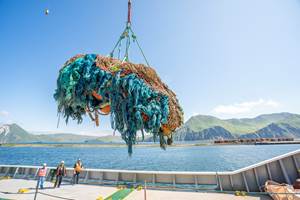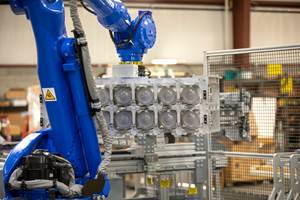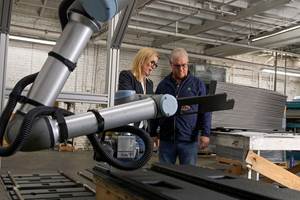The Super-Specialty Side of Thermoforming
Welch Fluorocarbon Inc. in Dover, N.H., produces nothing but tiny, super-thin thermoformed parts for critical applications.
Welch Fluorocarbon Inc. in Dover, N.H., produces nothing but tiny, super-thin thermoformed parts for critical applications. Evan Welch started his business in 1985 in Massachusetts. He had to develop his own processes for forming and heat-sealing fluoropolymer films into unique shapes for aerospace, medical, military, fire-protection and other high-value components. Most of Welch’s products use fluoropolymer films 5 to 10 mils thick, though he has formed film as thin as 1 mil.
Welch’s training came in the 1970s while working at American Durafilm in Holliston, Mass., where he developed a way to vacuum form 8 x 12 in. sheets of DuPont’s Teflon FEP into sheets of steep-sided bumps that were then die-cut into tiny insulating sleeves for pacemaker batteries. “That began a focus on vacuum forming of fluoropolymers,” he recalls. “DuPont would send me leads, and I would figure out how to make what they wanted. I became the person to talk to.”
Once he started his own company, he continued to develop that specialty, designing and building his own single-station vacuum forming machines with very rapid heating and high-temperature capability. The machines use two 6800-watt heater banks made of a special Nichrome resistance ribbon fabricated for Welch by Process Thermodynamics Inc. in Brandon, Minn. These units heat up in less than a minute to a surface temperature of over 1000 F. His three production machines are identical to one lab line used for prototyping, so when a part goes commercial, he simply moves the tools from the lab to the production area.
No-fail parts
In Welch’s markets, there’s no room for product failure. His custom products include corrosion barriers for air regulators in gas masks and a liner of DuPont’s Kapton polyimide for a smoke hood used by commercial flight crews. The Federal Aviation Administration requires the hoods to withstand 1000 F for 5 seconds and to keep a person alive for 20 minutes in an oxygen-depleted environment.
NASA came to Welch for PE bags that astronauts could urinate into. Welch is the sole supplier of these vacuum-formed bags, which are folded over and heat sealed with Kapton adhesive tape to reinforce the edges. They cost $40 each and take 28 manufacturing steps to make.
Welch also makes dozens of types of pacemaker battery insulator sleeves. One of the most challenging is formed of 10-mil fluoropolymer film and measures just 0.25 x 0.5 in. but is drawn 2-in. deep.
Quality control for such critical products requires a positive working environment, Welch believes. He pays extremely generous benefits to his 25 employees: 100% of medical insurance at a cost of $11,000 per family and a 401K program with 50% matching of employee contributions up to 10% of salary. When one employee developed multiple sclerosis, Welch redesigned that man’s job so he could keep working. As a result, Welch Fluorocarbon won the National MS Employer of the Year Award in 2000.
Pro-active inventions
Sometimes Welch develops a process before he has a customer, figuring that once he can make it, someone will want it. For example, in 1988 he successfully vacuum formed Honeywell’s Aclar CTFE, a highly crystalline material with a Tg of 360 F. He heated a sheet of Aclar to 440 F to make it amorphous and easily formable, then cooled it to room temperature so fast, it didn’t have time to regrow crystals. He thus obtained clear, thin, flexible CTFE parts. He now vacuum forms over 20,000 lb/yr of CTFE for parts like moisture-protection covers for electrical circuitry. He designed and built two special automatic thermoforming machines just for the moisture covers.
Welch recently developed a unique process to form a sheet of 5-mil Teflon film over substructures like a foam donut or a silicone gasket. It took him six months of work. The process is being considered for gaskets for sanitary piping. Welch charges customers the full cost of his R&D time. “We’re not afraid to charge the customer for that which is unique,” he explains. “But mostly, I want people to look at one of my parts and say, ‘How the hell did he do that?’”
Related Content
Thermoforming PCR: An Equipment Supplier’s Pointers
Thermoforming PCR is not radically different from forming virgin, but variation in recycled materials can require extra care to get a consistent end result. Start by examining every aspect of the process from the sheet (and extrusion process if run inline) to the final trim.
Read MoreManufacturer Helps Clean Up Global Waterways with Reclaimed Plastics
RSP and Oceanworks partnership diverts plastic wastes from waterways for incorporation into new products.
Read MoreAn Automation 'First' for Non-Servo-Eject Trim Presses
Compact, flexible and configurable robotic system is said to be the first to enable thermoformers to fully automate product handling after a non-servo trim press.
Read MoreCobot Creates 'Cell Manufacturing Dream' for Thermoformer
Kal Plastics deploys Universal Robot trimming cobot for a fraction of the cost and lead time of a CNC machine, cuts trimming time nearly in half and reduces late shipments to under 1% — all while improving employee safety and growth opportunities.
Read MoreRead Next
Processor Turns to AI to Help Keep Machines Humming
At captive processor McConkey, a new generation of artificial intelligence models, highlighted by ChatGPT, is helping it wade through the shortage of skilled labor and keep its production lines churning out good parts.
Read MoreWhy (and What) You Need to Dry
Other than polyolefins, almost every other polymer exhibits some level of polarity and therefore can absorb a certain amount of moisture from the atmosphere. Here’s a look at some of these materials, and what needs to be done to dry them.
Read More























